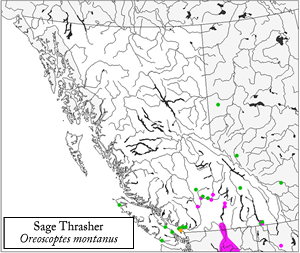The Sage Thrasher is a fairly distinctive and easily identified species, particularly given its narrow habitat preferences. It is most likely to be confused with adult and juvenile Northern Mockingbird, a regular vagrant to British Columbia (and extralimital breeder) that could occur in habitats that are frequented by Sage Thrashers. Adult Northern Mockingbirds should be easily distinguished, however, by the large white flashes in the wings, extensive white outer tail feathers, paler grey upperparts and head, and unstreaked underparts (although most worn Sage Thrashers in mid- to late summer have largely lost the dark streaking on the underparts). Juvenile Northern Mockingbirds are overall buffier than adults and have faint darker spotting on the breast, and are thus more similar to Sage Thrasher. Like adults, however, the prominent white patches in the wings and tail should serve to easily distinguish these individuals from Sage Thrasher.
| The male’s song is a prolonged, soft warble of mellow, rolling or churring whistled notes that changes periodically in tempo but generally does not change in pitch; accented phrases are sometimes interspersed throughout the song. The song is often relatively quiet and can be easily overlooked. Calls include a low chup or chuck (similar to Hermit Thrush, but harder) and a sweet, high wheeurr. The Sage Thrasher occasionally mimics the calls of other bird species, including the Western Meadowlark, Brewer’s Sparrow, and Horned Lark. Source: Reynolds et al. (1999); Sibley (2000) |
Courtship
Pair formation occurs on the breeding grounds within a week of the arrival of females. Aside from song, the male Sage Thrasher also uses several courtship displays that are designed to both attract a mate as well as establish territorial boundaries. Males occasionally fly in undulating circles low over sagebrush habitat while singing, occasionally at heights of up to 8 m or dipping as low as the tops of the sagebrush. Upon alighting following these song flights, the male commonly raises one or both wings and flutters them for several seconds while continuing to sing.
Nest
Both sexes contribute to the construction of the nest, which is built within 1-2 weeks of pair formation. The nest is placed in a low shrub (typically a sagebrush, but sometimes placed in other species such as rose, Saskatoon, cherry, snowberry, etc.), and is usually placed in one of the larger, denser shrubs within the territory. Nest heights range from 0.1-1.5 m; some pairs may nest on the ground, although this has not been confirmed in British Columbia. The nest is a bulky cup (18-20 cm wide and ~10 cm deep) of coarse twigs and strips of bark that is lined with grasses, rootlets, hair, and fur; some nests are partly concealed by an overhanging canopy of branches.
Eggs
A single clutch of 4-5 (7) eggs is laid between late May or early June and mid-July and is incubated by both sexes for 11-17 days before hatching. The smooth, glossy eggs are deep, rich blue or greenish-blue and are boldly spotted with large, well-defined brown, reddish-brown, buffy, or grey markings that are often concentrated around the larger end (commonly forming a “wreath”). There are no instances of Brown-headed Cowbird parasitism of Sage Thrasher nests in British Columbia, and it is an extremely rare host elsewhere in North America. Eggs are present in B.C. between late May and late July.
Young
The nestlings are fully altricial and largely naked to sparsely downy upon hatching, with dark brown skin and tufts of blackish or dark bluish-black down on the head and body; the mouth cavity is bright orange to yellowish. The young remain in the nest for 10-14 days before fledging, during which time they are tended by both parents. After fledging, the young remain with and are tended by both parents for an additional week before dispersing and becoming fully independent. Nestlings and dependent fledglings have been recorded in British Columbia between mid-June and mid-August.
Source: Baicich and Harrison (1997); Campbell et al. (1997); Reynolds et al. (1999)
|
This species forages almost exclusively on the ground. Prey is picked directly off the ground or gleaned from low hanging branches, and some prey items are even dug out of the ground. The diet consists largely of insects (especially ants and ground beetles) and spiders, particularly during the breeding season, although berries and fruits are also consumed when they are available. When consuming berries and fruits, the Sage Thrasher often picks them directly from the branches of small bushes, sometimes merely breaking the skin to sip the juices.
Source: Reynolds et al. (1999); Gebauer (2004)
|
|

